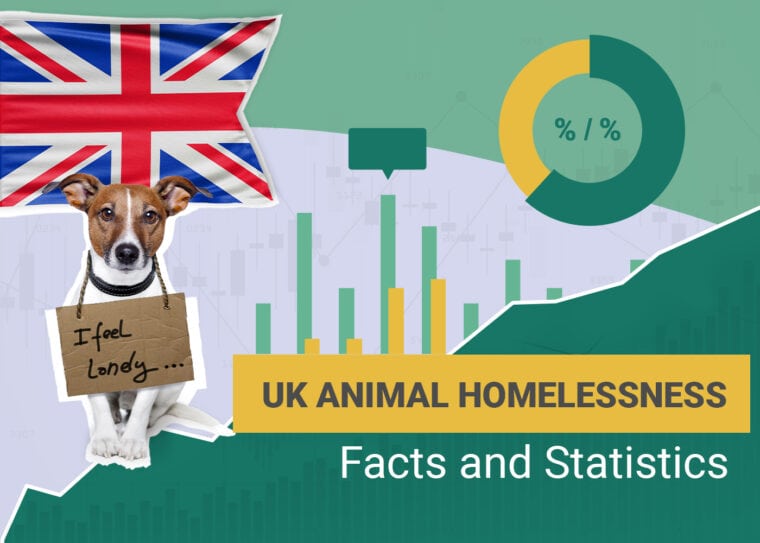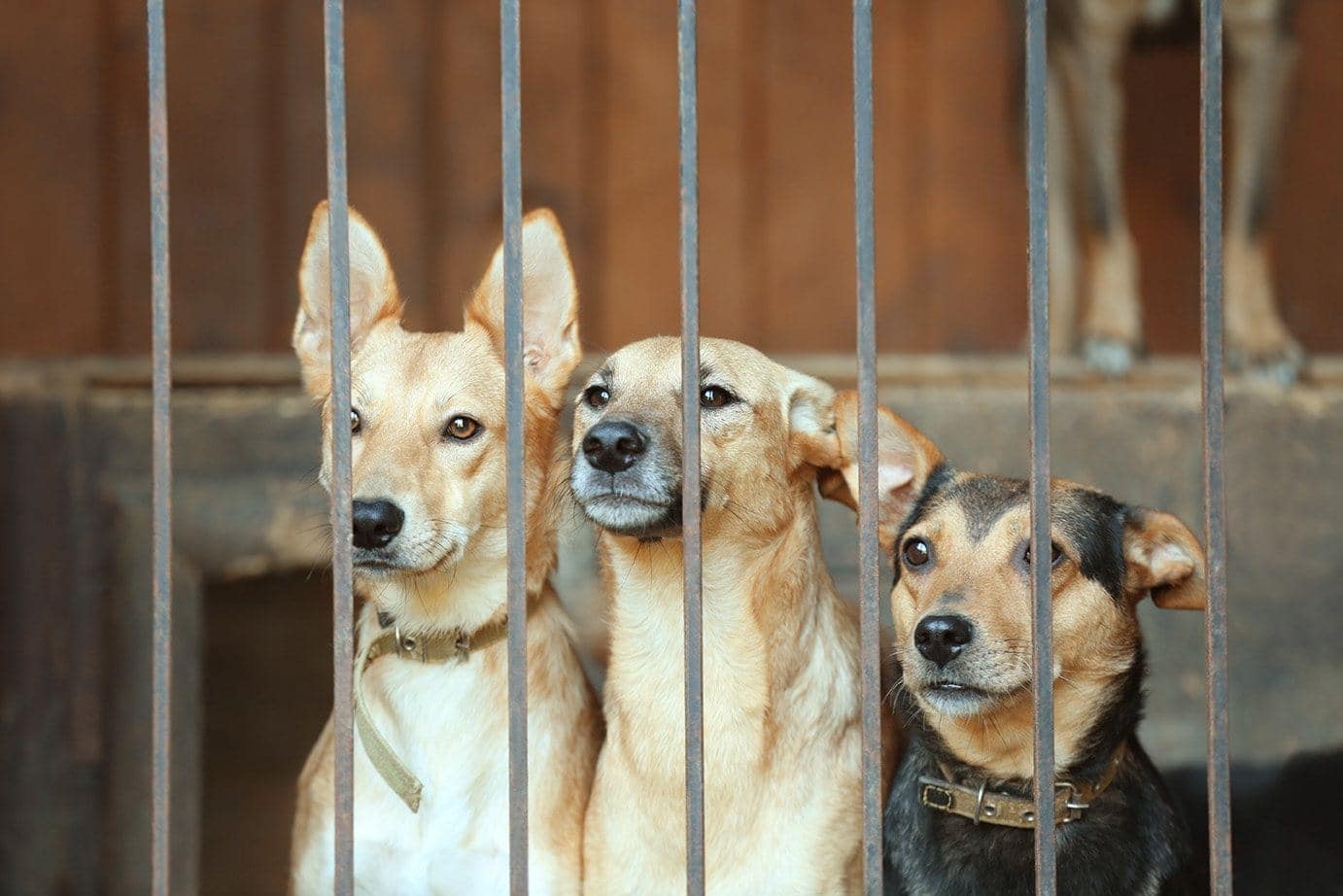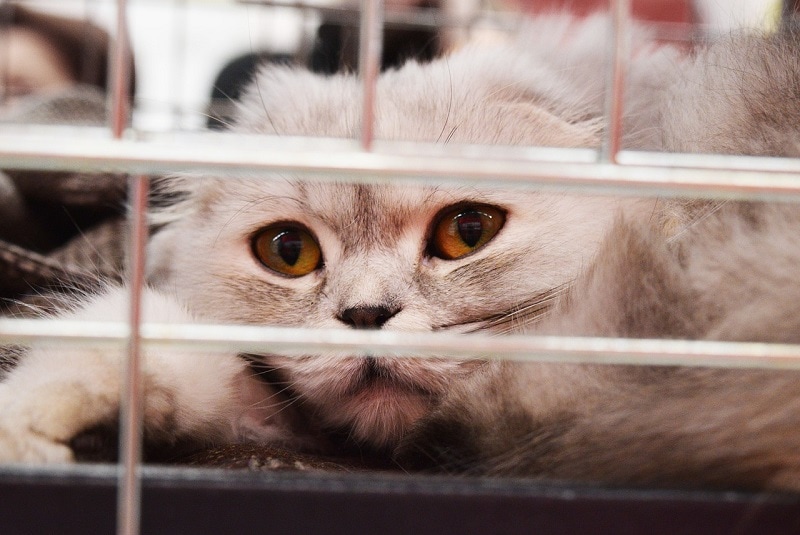
Click to Skip Ahead
Note: This article’s statistics come from third-party sources and do not represent the opinions of this website.
The UK is said to be a nation of animal lovers and the figures do bear this out. However, dig a little deeper and you will find that not all animals enjoy the same level of love and care. About a quarter of a million pets end up in shelters every year, and these shelters simply don’t have the room or resources to cope, resulting in dozens of dogs being euthanised every day. Read on for more alarming facts about UK animal homelessness and pet abandonment statistics.
The 15 UK Animal Homelessness Statistics
- There are 12 million pet dogs and 11 million pet cats in the UK.
- Roughly 57% of UK households (16.2 million) contain pets.
- Approximately 250,000 animals go to rescues every year.
- There are 1.1 million homeless pets living in the UK.
- 21 dogs are euthanised every day because they couldn’t be rehomed.
- In 6 years, an unneutered female dog and her offspring can produce 67,000 puppies.
- Only 20% of owners adopt their dogs from shelters and rescues.
- A quarter of new dog owners impulse bought puppies during COVID lockdown.
- 5.3 million pet owners are worried that they can’t afford the upkeep of their pets.
- 15% of new dog owners admit they weren’t ready for a new puppy.
- There are believed to be 67,000 stray dogs living on UK streets.
- In 7 years, an unneutered female cat and her offspring can have 370,000 kittens.
- 2.8 million cats are not microchipped.
- There are approximately 1 million stray cats.
- In some cities, there are roughly 57 stray cats per square kilometer.

Pet Ownership And General Animal Homelessness
1. There are 12 million pet dogs and 11 million pet cats in the UK.
(Statista)
Although the numbers are close, dogs remain the most popular pet in the UK with 12 million loyal companions in UK homes. There are also 11 million pet cats. These numbers are estimates because many owners still do not have their pets microchipped, so it is impossible to keep track of exact numbers, although laws have been recently passed that makes microchips required by law.

2. Roughly 57% of UK households (16.2 million) contain pets.
(Improve Veterinary Practice)
Although dogs and cats are the most popular and prevalent pets, people keep a host of other animals. Small, caged animals like hamsters and guinea pigs remain popular because they require less care and cost less money to keep than dogs and cats. It is rabbits, however, that are the third most popular pet. More exotic animals like lizards and snakes have become a bit more popular, as they are becoming easier to get hold of.
3. Approximately 250,000 animals go to rescues every year.
(UK Parliament)
For a wide variety of reasons, people abandon their pets every year. These pets are either left to live on the streets, where they will become malnourished and often die, or they are taken in by shelters and rescue centres. In fact, a quarter of a million animals a year, or nearly 700 animals a day, are sent to shelters.
4. There are 1.1 million homeless pets living in the UK.
(Mars Petcare)
As well as the cats and dogs currently in shelters yet to be rehomed, there are 1.1 million cats and dogs that live on the streets or are stray. These animals are often abandoned by previous owners but they also stray. Stray animals are those that are not microchipped and that get out of the house and are unable to find their way home again. Legally, all dogs and cats should be microchipped in the UK.

Dog Homelessness
5. 21 dogs are euthanised every day because they couldn’t be rehomed.
(PETA)
Unfortunately, shelters and rescues are overloaded with more animals and there are far more cats and dogs than potential owners. This means that many animals are euthanised, with some shelters operating a strict time-based policy. If a perfectly healthy and well-adjusted dog doesn’t find a new home in a set amount of time, they are put to sleep.
6. In 6 years, an unneutered female dog and her offspring can produce 67,000 puppies.
(PETA)
Dogs usually reach sexual maturity between 6 and 12 months of age and it is important to get dogs neutered or spayed, because this will help reduce the number of unwanted dogs that find their way into shelters. A single female dog can have as many as 3 litters in a year, and the average size of a litter is 6 puppies. This means that a single unneutered female, her offspring, and their offspring, can lead to as many as 67,000 puppies in 6 years.
7. Only 20% of owners adopt their dogs from shelters and rescues.
(STATISTA)
There are many reasons people choose to buy a dog rather than adopt one from a shelter. Some potential owners want a specific breed while others are wary of the reasons that a dog was abandoned in the first place. As a result, only about one in five dog owners got their pets from a shelter. Other sources include breeders, private sellers, puppy mills, and family and friends.

8. A quarter of new dog owners impulse bought puppies during COVID lockdown.
(Kennel Club)
At the beginning of COVID lockdown, many people turned to physical activity as a means of staying fit, getting healthy, and passing the time. The extra walking and time outdoors saw a lot of people consider a new pet. One in four new dog owners got their new puppy during lockdown.
9. 5.3 million pet owners (21%) are worried that they can’t afford the upkeep of their pets.
(Tesco Bank)
Although there is nothing inherently wrong with getting a new puppy as a means of encouraging more physical activity, research shows that 5.3 million pet owners ( 21%) are concerned about affording the upkeep of their pets, with half of dog owners and one-third of cat owners cutting how much they spend on their pets. ABout 48% of pet owners have cut back on their own essentials to be able to afford pet costs.
10. 15% of new dog owners admit they weren’t ready for a new puppy.
(Kennel Club)
A similar percentage of new owners also admit that they weren’t really ready for a new puppy. Owners are encouraged to research the impact of owning a dog because they do require a lot of attention. It is more difficult to find the time to provide an hour of walking a day when back in full-time work.
11. There are believed to be 67,000 stray dogs living on UK streets.
(Mars Petcare)
There are various reasons that dogs become stray. They may have been born to a stray dog themselves. Alternatively, they may have once had a home and the owner no longer wanted them, or the dog wasn’t microchipped and escaped from the house. 67,000 such dogs are thought to live on the streets, in abandoned buildings, and in other locations around the UK.

Cat Homelessness
12. In 7 years, an unneutered female cat and her offspring can have 370,000 kittens.
(PETA)
Cats are even more prolific breeders than dogs, and a single unneutered female cat, and her offspring, can result in 370,000 unwanted kittens in just 7 years.
13. 2.8 million cats are not microchipped.
(Cats Protection)
Microchipping a cat enables owners to be reunited with their cats if they go missing or get out. The process requires a small microchip to be placed under the cat’s skin. Vets and animal welfare officers can scan the cat, locate the chip, and find the owners’ details using the microchip registry. Not only does this benefit the owner and the cat but it helps reduce the total number of stray cats on the streets and the number that end up in shelters. However, microchipping laws have recently been put into place that will hopefully lower these numbers.

14. There are approximately 1 million stray cats.
(Mars Petcare)
Similar to dogs, cats can end up stray for many different reasons. As well as those that are born to stray cats, there is a large population of feral cats. Feral means a domesticated animal that has reverted to living wild or an animal that was never domesticated in the first place. Feral cats can live in fields, barns, and around farms, but they can also live in urban environments. In total, there are more than 1 million stray and feral felines in the UK.
15. In some cities, there are roughly 57 stray cats per square kilometer.
(Yahoo)
Stray and feral cats tend to live in areas where food is rife. This is why they congregate around farms: there is a proliferation of seed and feed that attracts mice and other prey. It is also why they live in urban areas, where they can scavenge from bins and other sources. In fact, in some cities, there are estimated to be roughly 57 stray cats for every square kilometer of space.
Frequently Asked Questions
How Many Stray Dogs Are There in the UK?
Although it is impossible to know the exact number, there is estimated to be at least 67,000 stray dogs in the UK. Dogs are abandoned because their owners couldn’t cope, couldn’t afford their upkeep, or simply didn’t gel with the dog. (Mars Petcare)

How Many Stray Cats Are There in the UK?
Again, it is impossible to give an exact figure but best guesses indicate approximately 1 million stray and feral cats. As well as those that live on the streets of towns and cities, where they eat rubbish and leftovers, there is a large rural population that live in barns and on farms. (Mars Petcare)
How Many Stray Animals Are There in the UK?
With 67,000 stray dogs and 1 million stray cats, there are at least 1.1 million stray animals in the UK. (Mars Petcare)
Is It Illegal to Abandon a Dog in the UK?
According to the Abandonment of Animals Act 1960, it is a criminal offense to willfully abandon an animal if it is likely to “cause the animal any unnecessary suffering”. This means that while it is illegal to throw a dog out on the street, it is not generally considered illegal to surrender one to an animal shelter.

Conclusion
Although figures do show that the UK is a nation of animal lovers, and the vast majority of pet owners do take good care of their animals, figures also suggest that this isn’t the case for all pet owners. More than a million pets are left to roam the streets or end up in shelters in the hope of finding their forever home. We hope this article has shed some light on the animal homelessness problem in the UK.
Featured Image Credit: pmwtastro, Pixabay








